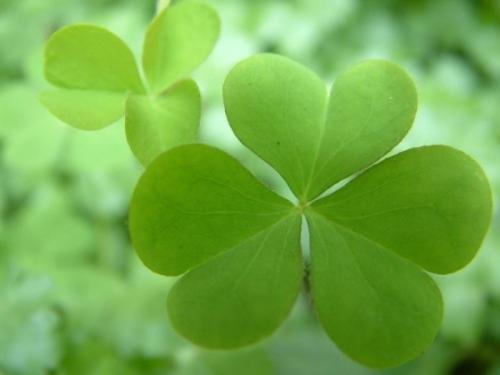I had always thought that, being a simple genetic anomaly, four-leaf clovers would be fairly common.
四葉草是一種簡(jiǎn)單的遺傳疾病,我一直覺(jué)得它是很常見(jiàn)的。
I have since learned that one in 10,000 clovers has four leaves.
后來(lái)我了解到在每10000株三葉草中就有一株四葉草。
It could be the result of a recessive gene, a so-matic mutation, the influence of environment, or any combination of the three.
它可能是由一個(gè)隱性基因表達(dá)、一個(gè)體細(xì)胞基因突變、受環(huán)境影響或由以上三個(gè)因素任意結(jié)合而導(dǎo)致的結(jié)果。
But isn’t this where science meets magic?
但是這不就是科學(xué)遇上魔法的地方嗎?
Though I find clovers all the time, I’m not exceptional in this skill.
雖然我總是能發(fā)現(xiàn)三葉草,但是在這項(xiàng)技術(shù)上我并不特殊。
The Guinness World Re-cords holder, Edward Martin Sr. from Cooper Landing, Alaska, had found 111,060 four-leaf clovers when he took the record in 2007.
老愛(ài)德華·馬丁來(lái)自阿拉斯加的庫(kù)珀蘭丁,他是這方面的吉尼斯世界紀(jì)錄保持者。他在2007年創(chuàng)該項(xiàng)紀(jì)錄時(shí),已發(fā)現(xiàn)了111060株四葉草。
It’s the finding I love, not the collect-ing. I’m happiest to give my “l(fā)ucky” clovers away.
我喜歡的是結(jié)果,而不是收集的過(guò)程。把我的“幸運(yùn)”四葉草贈(zèng)與他人時(shí),我是最快樂(lè)的。
I pass them on to moth-ers in parks, who show them to their wide-eyed kids.
我把它們送給公園里的母親們,這些母親會(huì)把它們展示給他們大眼睛的小孩子們。
I delivered one to the man at my corner store, where it hangs above the register.
我把一株四葉草寄給了街角小店的店員,就掛在收銀臺(tái)上方。
Friends slip them between the business cards in their wallets for safekeeping. People ask how I do it.
為了安全起見(jiàn),朋友們會(huì)把它們夾在錢(qián)包里的名片之間。人們問(wèn)我是怎么做到的。
Well, I love clover: the sweet smell, the common variant with its cute trio of leaves.
我喜歡三葉草:它們有甜美的氣味,常見(jiàn)的三葉草變種,可愛(ài)的三片葉子。
I look at it more than most people do. I expect that’s the first reason I find so many.
我看它的時(shí)間比大多數(shù)人都多。我覺(jué)得這就是我能發(fā)現(xiàn)這么多四葉草的首要原因吧。

I have a habit of dragging my fingers or toes across a patch, mo-mentarily separating the individuals, which brings irregularities into fo-cus.
我有一個(gè)習(xí)慣,就是在一片土地上劃動(dòng)我的手指或腳趾,隨時(shí)的分開(kāi)長(zhǎng)在一起的草叢,這就讓不規(guī)則的植株成為焦點(diǎn)。
That’s part of finding them: not a hardening of focus, but a softening. The other reason is artful.
這就是找到它們的一部分:不是加強(qiáng)專注,而是柔化。另外一方面是藝術(shù)的原因。
Do you re-member those posters from the 1980s made up of thick dots? If you looked too hard, all you’d see was the pattern.
你記得20世紀(jì)80年代的由密集的點(diǎn)構(gòu)成的海報(bào)嗎?如果你很仔細(xì)地看,你看到的只是一種形式。
But if you let your eyes slip out of focus, scenes would appear: dinosaurs, land-scapes, butterflies—a trick of the eye.
但是如果你的眼睛沒(méi)有聚焦,畫(huà)面就會(huì)出現(xiàn):恐龍,風(fēng)景和蝴蝶—這是眼睛的把戲。
It’s the same with four-leaf clovers. If you try too hard, you will only ever see the patch.
尋找四葉草也是一個(gè)道理。如果你太專注的話,你只會(huì)看到那片土地。
Instead, slip into a lazy, soft-focus, summer state of mind. Drift your hand across a thick patch, letting the clovers reveal themselves.
相反,你應(yīng)該進(jìn)入一種懶散、注意力不集中的夏季心態(tài)。將你的手劃過(guò)一片厚厚的草叢地,讓三葉草露出來(lái)。
Appreciate the ones that have only three leaves. Common things are beautiful too.
欣賞那些只有三片葉子的三葉草。常見(jiàn)的事物也是美麗的。
And a four-leaf clover may show itself to you. Just like that.
而四葉草或許就會(huì)出現(xiàn)在你面前,就像那樣。
That day in third grade, I dived into the clover patch, skimming the sur-face with my hands, softening my eyes to look for irregularities.
三年級(jí)的那一天,我潛入了三葉草叢里,用我的手掠過(guò)表面,使我的眼睛變得柔和,來(lái)尋找不規(guī)則的植株。
It took only moments for a four-leaf clover to fall into my fingers. Just like that.
只消片刻,一顆四葉草就落到了我的手里。就像那樣。
Whatever little toy I won that day, my real prize was the gateway that the simple act of looking for clovers opened for me into a lifetime of joy de-rived from looking closely.
不管那天我贏得了什么玩具,我真正的獎(jiǎng)項(xiàng)是這個(gè)簡(jiǎn)單的尋找三葉草的行為為我打開(kāi)了一扇門(mén),讓我通向由近距離欣賞事物獲得的快樂(lè)的一生。
The magic of nature coming up as it pleases.
大自然的魔力隨之而來(lái)。



